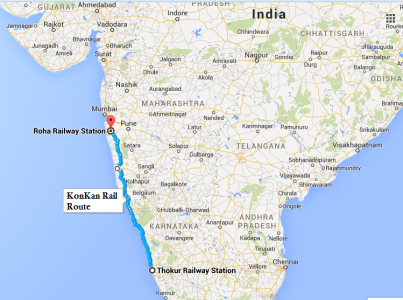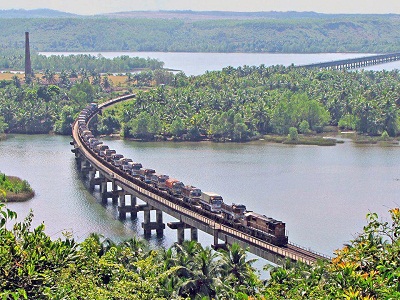Published on: 9/20/2015IST
Story of Incredible Construction: The Konkan Railways
|
Konkan Railway is a railway line that runs along the west coast of India, parallel to the Arabian Sea and the Western Ghats. This rail route is constructed and operated by Konkan Railway Corporation. The railway line extends from Roha in Maharashtra till Thokur in Karnataka thereby covering a length of 741 km. During its entire course it passes through several rivers, mountains and the Arabian Sea thereby making the construction of railway track almost impossible. Once the line was completed it offered some of the spectacular natural scenery during its journey. |
Complete Route of Konkan Railways from source to destination stations |
|
As the railway line is sandwiched between the Arabian Sea on one side and the Western Ghats on another,2000 bridges and 92 tunnels were required to complete this railway track. According to sources the amount of input required to construct this line was one of the most difficult tasks undertaken to be completed in 20th century. Reason for Konkan Railway: India has of the greatest and 4th largest rail network in world and almost every part of India was connected via rail network excluding some parts of eastern India. Britishers also kept their hands off to this as they also knew that developing railway line in this part of India is a tough job and requires lot of manpower and money and in case they succeed they will have to fight with nature. To construct a rail line becomes difficult in rainy season as this part of India receives some of the highest rainfall in the country. Since one side was the Arabian Sea and on the other side the Great Western Ghats therefore tunneling was difficult. Not only rocks but also the highlands were made of soft and clayey soil. The problem was further aggravated by land acquisition as it needed the organization to negotiate with forty two thousand land owners. All these troubles made successive rail ministers to keep their hands off, but it severely affected the trade and transportation. The local merchants had to follow a much longer route thereby increasing the cost of transportation. Finally Indian Government approved the construction of railway line and on September 15, 1990 foundation stone at Roha was laid. Construction of Railway: Dr. E. Sreedharan was made director to construct this line and he was given full power to recruit and work. Entire length was divided into 7 parts headed by one chief engineer and they were asked to provide best path to pass railways. Satellite images were taken and long surveys were done by enthusiastic engineers to finalize the route. Next was land acquisition and the team contacted local panchayats and leaders. Compensation amount was offered depending upon the type of soil and trees and it was promised that they will get job in railways on its completion. For construction companies like L&T and AFCONS were given contracts and large Tunnel Boring Machines (TBM) were imported from Sweden. 30 thousand workers were employed and a time limit of 5 year was set. Though the project took 7 years to complete and cost 93 workers their life, but once the line was complete it was an immediate hit. It reduced the time of travel between major cities like Mumbai to Goa and Cochin by 10 and 12 hours respectively. |
|
|
A walk through Railway Line: Entire Konkan Railway line passes through 3 three Indian states i.e. Maharashtra, Goa and Karnataka. There are 56 railway stations and entire line is single track with no electrification. Track is designed for a maximum speed of 160 km/hr. The route provides some of the best natural views and scenic beauty. As Arabian Sea is on one side and lush green Sahyadri Mountains on other, nearly 2000 big and small bridges and 92 tunnels were constructed. At the time of completion all the longest tunnel of India were present on this line and the Karbude Tunnel (6.5 km) was the longest one. Panvell Viaduct (210 ft.) constructed on this line was third tallest viaduct in Asia when the line was completed. The entire length can be divided into three parts on the basis of state it crosses. They are:
|
Train Passing through Panvell Viaduct (210 ft.) when construction completed it was third tallest viaduct in Asia. |
|
RORO train passing through Hannavar Bridge on Sharavati River. Image Source: www.railpictures.net |
Length in Maharashtra: Major part of Konkan Railway lies in the state of Maharashtra and it shares 375km of railway line. Starting from Roha, the last station that lies in Maharashtra is Madure. Important stations in Maharashtra are Roha, Chiplun and Ratnagiri. Length in Goa: Goa has fairly small share as compared to other two states. Major challenges were faced while carrying out the construction work in Goa. Many bridges were constructed to pass railway line through the rivers flowing in Goa. The bridge on Zuari River in Goa, is 1319 m long. In Goa total length of railway line is 110 km starting from Pernem Railway station to Asnoti, Madgaon being the main railway station. Length in Karnataka: In Karnataka last station of Konkan Railways is Thokur though the line leads to Manglore railway station which is managed by Southern Railways. In Karnataka total length of railway line is 245 km. Udupi and Karwar are important stations in Karnataka. |
|
Impact, Current status and Tourist Spot: From the beginning, railway line was an instant hit. It helped in reducing travel time between major cities of India by 10+ hours. Travel time between Mumbai and Mangalore was reduced by 26 hours. As it offered beautiful scenery along the route it became one of the favorite rail route. Most trains that were bound to Kerala and other south Indian states were diverted on this line, it helped in boosting tourism industry. Locals too benefited from this project as they got jobs in Konkan Railway Corporation as promised. It marked the development of region and traders got wide opportunity to sell their products. Many advanced features were introduced like Roll-on/roll-off (RORO) service and introduction of Double Decker trains. Konkan Railway has two different time-tables, one for regular season and other for the monsoon season. At present it carries 25 million passengers every year. As organization still has to repay a heavy debt, they are planing to introduced more new features and larger number of RORO trains. Konkan Railway plays a major role in reducing the travel time to Goa, which is a major tourist destination in India. The railway line was extended to Kerala and helps in boosting Kerala tourism industry. In past to reach Kerala, the passengers had to follow a longer route from eastern side of India. Now the trains are extended from Mangalore to the various cities in Kerala. For Indian’s its is a matter of great pride and respect for dedicated work of their engineers and workers. For foreigners it is best train route to travel through western India. Dedication of engineers working on this project can be understood from following lines: “I take the vision which comes from the dreams, apply the magic of science and mathematics adding the heritage of my profession to create a design: I am an engineer I serve mankind by making dream come true.” |
|
9/20/2015 | | Permalink



